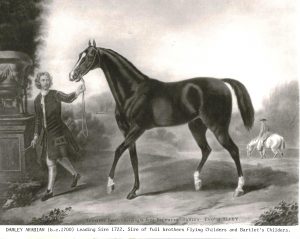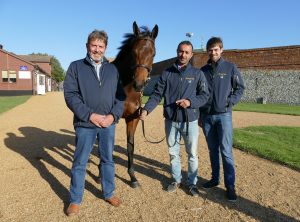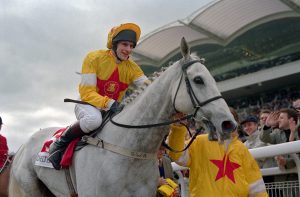When Macaroni won the 1863 Derby, the bells rang out in Newmarket. People had begun to doubt whether the town would ever produce another Classic winner, such was the domination of John Scott and other Yorkshire trainers. Yet Pretender, six years later, remains the last colt to win the race – at Epsom, that is, Dante having won a wartime substitute at Newmarket – for the White Rose county.
Libertarian very nearly stopped the rot when charging down Ruler Of The World three years ago, while Ribchester and Quiet Reflection are only the latest of many to have recently enriched the great Turf heritage of the moors. But if Yorkshire’s Flat trainers are making significant progress, the prospects of an equivalent revival among her breeders would seem as remote as ever. And, if anything, that represents a still bleaker contrast with the proud days of yore.

The Darley Arabian was imported from Syria to Yorkshire in 1704
For this was the cradle of the thoroughbred. Nearly all the foundation mares listed in the first General Stud Book, late in the 18th century, had grazed the pasture of the Dales. Likewise dozens of stallions imported from the fringes of the Mediterranean, between 1650 and 1750, who together seeded a hybrid racehorse from native stock.
The Darley Arabian himself, source of the male tail in 19 out of 20 modern thoroughbreds, was sent from Aleppo in 1704 to the estate of a Puritan squire a few miles from York. Marske, the sire of Eclipse, was named after the enchanted nook of Swaledale where he was bred by John Hutton. Long before the county gentry had begun to develop their own studs, moreover, the earliest British experiments in selective breeding of livestock had been undertaken locally by Cistercian monks.
One way or another, then, the roots of the thoroughbred extend deep into Yorkshire soil. Which makes the struggles of breeders there today all the more poignant – and, in one or two heartening cases, all the more provoking to their energy and ambition.
“When we started, in the seventies, it would take two hands to count the number of farms round here,” says Richard Lingwood, who presides over one of the last outposts at Norton Grove near Malton.
“Now you’re down to us; Steve Knowles at Beechwood Grange; Andrew Spalding at Darlington; and after that it’s a struggle to think of anyone else [standing a stallion].
“We’re lucky enough to be kept busy, boarding mares and their offspring. But, with the way transport is nowadays, we’re walking more of them into other studs all round the country than we’re taking to our own stallions.”
Lingwood is staying positive, and indeed hopes to find a fresh name to join Monsieur Bond and Milk It Mick. But Knowles speaks advisedly when he describes breeding in Yorkshire as “a tough old game that’s getting tougher.” At the start of the year, he was supervising three stallions at Beechwood Grange.
But Haafhd has moved down to Gloucestershire, while Desideratum was put down after savaging Knowles in a terrifying incident in May. That leaves Sleeping Indian, aptly enough one of the last hopes of the beleaguered sire-line tracing to the Byerley Turk – another of the breed’s three patriarchs to have been based in the north.
“Sleeping Indian can get very nice horses, like Crazy Horse with John Gosden,” Knowles says. “He’s now won three out of four, including the Horris Hill. So it can be done. And the history is there. We have some of the best feeding land there is for growing bone. It’s strong land and they feed like the devil on it. We’ve been here 40 years, and we’ve got very experienced people. But it’s all about fashion, isn’t it?”
Some argue that the challenges facing northern studs at this level are national, not regional – and trace to the commercial aggression of certain Newmarket behemoths with their bush-league stallions.
But Lingwood, for his part, blames the lazy drift of fashion. “Take Monsieur Bond,” he says. “He’s done us proud. And he’s had his periods of being in fashion, too, when for a couple of seasons he was covering 115 or 120 mares. But without that headline horse the agents don’t bother looking into the facts.
“He has had over 50 winners so far this year, and just look at the fees of the stallions surrounding him in the table. He’s advertised at £4,000 and hasn’t covered many black-type mares. But if he doesn’t get that big winner, a Move In Time winning the Abbaye, nobody notices how well he’s been doing.”
Not everybody is quite so myopic, however, judging from the Monsieur Bond filly sold at Deauville in August for €145,000. “And we’ve a loyal band of people who come back every year, thank goodness,” Lingwood adds. “But I’d like to find a fresh stallion, if I could. As much as anything because it would help the others as well. People come and look at one and then they see what else you’ve got.”
In the beautiful setting of Norton Grove, any new recruit would be following in the footsteps of a Derby winner, Morston, and a St Leger winner, Bollin Eric. And perhaps the 21st century tide can still be turned.
According to two relatively new players, however, bias will not be overcome simply by clinging to the past. Both have entered the game with a completely fresh slate, unabashedly investing a business fortune in a field that has notoriously been the preserve of experts in an arcane, inherited lore. And both are backing their own judgement, as tried and tested in other walks of life.
The rags-to-riches story of Ritchie Fiddes was crowned three years ago when, still in his early thirties, he sold his IT business for £23 million. He had already dipped his toe in the water as an owner, and is a partner (along with Harry Redknapp) in the Group 1-placed sprinter Moviesta. But he soon sensed a certain rigidity in the industry, in the way not just knowledge has always been handed down from one generation to the next, but also the businesses based on that knowledge, the training yards and studs.
We have some of the best land for growing bone; it’s strong land and they feed like the devil on it
After trying to look at the whole process afresh, in March Fiddes purchased the young stallion Albaasil to stand on the farm he has developed near Ripon.
“With my IT background, as you can imagine, I was interested in a statistics-based approach,” he explains. “Everyone had told me that the mares were most important but it’s in the stallions that the traits come through consistently in conformation, wind, everything. After a couple of years I started buying my own yearlings. I’d done my own homework, and seen that the best horses in the yards I was in at the time were also by the best stallions. And if you start on the basis that stallions can upgrade mares, you can come out ahead of the curve.”
Of course, statistical samples for stallion progeny are far bigger than the equivalent for mares – and Fiddes perceived spikes in the data he collated on various sires. Two were Dark Angel and Kodiac, now among the hottest stallions around. He spent just £30,000 on a yearling by the former at Doncaster, and was able to sell a half-share to Al Shaqab after Easton Angel won on her debut and then the Hilary Needler. She proceeded to beat all bar Acapulco in the Queen Mary.
Now Fiddes hopes he has spotted another neglected opportunity. “As you go on, you hope that you’ll get good racemares turning into good broodmares,” he says.
“And as I built up, I saw that there was a huge gap here in the north. You’ve got only a few stallions around, and yet you’ve got hundreds of mares paying boarding and travelling costs to go south – costs that will often add up to more than the covering fee.”
Albaasil may not mean a great deal to many people as yet – after all, he raced only four times for Sir Michael Stoute before a similarly brief career in Dubai, and only covered a small book of mares in his one year at Longdon Stud – but Fiddes is adamant that the eight-year-old son of Dansili has all the ingredients to make a name for himself.
“He was unlucky not to fulfil his potential through injury but definitely had Group 1 ability,” he says. “Doug Watson thought he was a superstar. Unfortunately he was balloted out on World Cup night and missed his big chance then. If you look at Dansili, he started out as an eight-grand sire with very modest mares. But he was upgrading them from day one and ended up as a six-figure cover. And see what his other sons have been doing: Zoffany, Requinto, Famous Name, Delegator, now Bated Breath. So again we’ve a great chance of being ahead of the curve.”
At a fee of £2,500 Albaasil already has 35 mares confirmed for the next covering season and Fiddes hopes to promote him past 50.
Unsurprisingly, given his determination to question received wisdoms, he has been using Equinome gene-testing on his horses from the outset. “And Albaasil has upgraded even the jumping mares he covered at Longdon,” Fiddes enthuses.
“You’d be worried that a middle-distance sire and a staying mare might produce slow horses, but he is adding speed to each and every foal. He’s a beautifully bred, 320,000-guinea Book 1 horse with an unbelievable temperament, and he’s really struck a chord.

Highbank Stud’s Martin and Tom Wainwright with Siraj Bahadar at Tattersalls
“The north has definitely been neglected, when you think how much of racing and breeding started here. For sure, there’s a huge commercial opportunity. But it will just be tremendously exciting to launch the stallion and race his progeny. We’re not going to sit around and see how the market reacts. We’re prepared to back him ourselves, and train his stock. If people come on the journey with us, great. After all, they can look round the country and they’ll find those options under ten grand, under five grand, are pretty hit-and-miss.
“It’s a phenomenally traditional industry and I respect the heritage and the prestige, all the methods handed down. But at the same time I’ve never been one to go round everywhere else and see what everyone else is doing. And I wouldn’t discourage anyone getting involved who is prepared to use common sense and attention to detail.”
It is very much on the same premise that Tom Wainwright is evolving another ambitious operation, Highbank Stud, just by Wetherby racecourse.
Wainwright’s father, Martin, began investing some of the proceeds of his Leeds construction firm in 2005, when spending 160,000gns on a Rock Of Gibraltar filly at Tattersalls October. The family were then launched on the giddiest of crash courses in the extremes of emotion on the Turf.
“Roxan won the Hilary Needler first time out!” Wainwright recalls. “And then started favourite for the Queen Mary. Kevin Ryan was talking about her as potentially the best filly he’d trained, and we spent that Christmas dreaming about the Guineas.
“Then, two weeks before the Nell Gwyn, Dad got the call that she had colic. And she couldn’t be saved. So our first experience of the game took us as high as we could possibly have hoped, then every bit as low.”
But the lesson was not wasted on them. “Dad saw then how difficult it would be to succeed on the track,” Wainwright says. “With the prize-money as it is, and you’re up against Godolphin and Juddmonte and all these huge operations. So we started to think of going in a different direction.”
They have since assembled a team of ten broodmares and, from a standing start, have recorded some remarkable results.
It was another Hilary Needler winner, Loch Jipp, who has twice hit the headlines for Highbank since her acquisition for 160,000gns at the horses-in-training sale in 2010: her two foals by Invincible Spirit were respectively top filly and top lot in the 2014 and 2016 Craven Breeze-ups, at 450,000gns and 360,000gns. But they had already hit the ground running.
“We identified quite early that in this game you’re better off aiming for Book I with a small quantity of high-quality mares than for Books 2 and 3 with a lot of average mares,” Wainwright says. “We believe that gives you the best chance of producing a good racehorse, and also the best chance of a return on your investment.”
They started out with a handful of mares and younger, track fillies. Again, they would soon sample ups and downs. Their agent Stephen Hillen spent $320,000 on a breeze-up filly by Lemon Drop Kid at Keeneland. Named Sweet Hope, she seemed to be going nowhere in Britain.
“Dad was thinking he’d spent all this money to be running in a handicap on a Tuesday night at Wolverhampton,” Wainwright says.
“But then we decided to send her to America and she took off, winning a Grade 3 and then coming second in the Grade 1 Test Stakes at Saratoga. We’ve kept her filly by Speightstown, White Royale, and she was impressive on her second start for Kevin at Newcastle.”
I saw that there was a huge gap here in the north; there are only a few stallions around
Another American import, a daughter of Malibu Moon named Miss Delila, was well beaten on her only two starts. But she has produced three dual winners already, including Ashadihan, who won the Group 3 Chartwell Stakes in May, while her Invincible Spirit filly sold for 280,000gns at Tattersalls Book 1 this October.
“We also got Miss Delila into Dubawi when he was only a 20-grand cover, and sold the resulting colt for 320,000gns as a yearling,” Wainwright says. “Without doubt that was our best result so far and it showed we were on point with our sire selection. That was a nice boost to our confidence. Dad and I are massively into our statistics and we draw up the matings we want to make before running them past Stephen, if he’s got any issues with conformation and so on.”
Aside from Hillen, Wainwright also credits new stud manager Siraj Bahadar for his all-round horsemanship, while Mark Dwyer has helped their profile at the sales by adding their draft to his consignments. But the owners of Highbank are also gaining in conviction with experience, already nearing the site’s maximum capacity and intent only on improving the quality.
“We’ll be looking at the Wildenstein dispersal and mares culled by Juddmonte or the Aga Khan,” Wainwright says. “We want to end up with high-quality Book 1 or 2 mares across the board.
“We accept we’ve come across some good fortune, so far, but at the same time we’ve bred the quality. Maybe we don’t get the same exposure in Yorkshire, maybe we’re small fish in a big pond, but all you can do in this game is have faith in the right people and by doing so we’ve already shown we can breed good racehorses. It’s a beautiful thing to see, these horses in a setting like this. And with all that history behind us, it’s great to be bringing a bit more of Yorkshire to Newmarket.”



